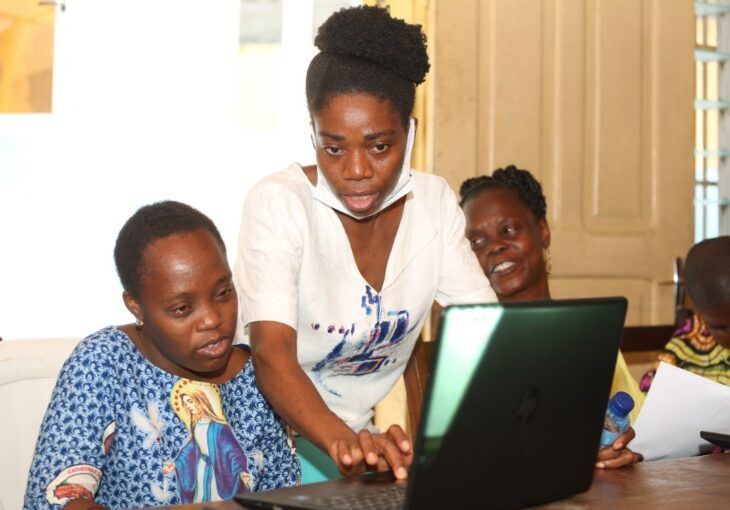Blog
Using Technology for Inclusive Education: Lessons from the GEM Report
- Inclusive education
The 2023 GEM Report found technology and assistive devices can enhance inclusive education when used appropriately. Studies show assistive technology improves outcomes for disabled students.
In September, Inclusion International and the UNESCO Global Education Monitoring (GEM) Report team organised a webinar discussing the 2023 GEM Report. Experts came together to discuss promising practices but noted ongoing challenges.

Speakers came together to talk about how technology can make education better for all students, including those with disabilities.
The experts who talked during this event discussed a lot of ideas for blending technology with education. They explained how technology can be a big help for students, especially those with intellectual disabilities.
If we truly want to achieve inclusive education for all, we need to consider those who can’t access digital technology—those at risk of being left behind.
Ceridwen Roberts, ATscale Partnership
Experts in attendance at the webinar included:
- Manos Antoninis, Director, GEM Report UNESCO
- Julia McGeown, Head of Inclusive Education, Humanity & Inclusion UK
- Sergio Ramirez Mena, Chief of Party, All Children Reading: A Grand Challenge for Development
- Ceridwen Roberts, ATScale Partnership
- Dorodi Sharma, Senior Advisor – Advocacy & Engagement, International Disability Alliance
- Juan de Cobeñas, a self-advocate learner, Inclusion International
- Mónica Cortés, Co-Chair, Catalyst for Inclusive Education
- Diane Richler, Co-Chair, Catalyst for Inclusive Education
- Sue Swenson, President, Inclusion International
Highlights from the Webinar
- Manos Antoninis, Director, GEM Report UNESCO gave the keynote address. His presentation discussed how using technology in education can be complex.
He framed the discussion around “tech on our terms”, where “digital technology should not be a substitute but a complement to human interaction.” Read Manos’ Full Highlights. - Julia McGeown from Humanity & Inclusion UK said that technology can help people with disabilities a lot. She said it should be seen as a tool that makes teaching and learning better, not something that replaces traditional teaching methods.
“Teachers can use technology to create their own teaching materials, making things more accessible,” explained Julia. Read Julia’s Full Highlights.
. - Sergio Ramirez-Mena from All Children Reading talked about the important role of teachers.
He said that teachers should get training and support to use technology to make learning materials that suit different students. Read Sergio’s Full Highlights. - Dorodi Sharma from Disability Rights Fund India said that using technology is not just a choice; it’s a right.
She mentioned the Convention on the Rights of Persons with Disabilities (CRPD), which says that everyone should have the right to use technology. Read Dorodi’s Full Highlights - Ceridwen Roberts from ATscale Partnership talked about how investing in the right places can lead to new and helpful technology, like programs that read text out loud in different languages.
This can help many students access education. Read Ceridwen’s Full Highlights - Juan de Cobeñas, a self-advocate from Asociación Azul, CIVICUS emphasized the need for training, low-cost options, and policies to promote equal access to technology.
Juan explained, “What we need is leadership of the education authorities, a clear policy on technology training of decision makers, teachers, and all those in the education system.” Read Juan’s Full Highlights.
Watch Webinar
The 2023 Global Education Monitoring Report highlights the potential of technology to expand access to education.
But technology alone can’t solve everything. We need supportive policies, enough money, cooperation between different groups, good training, and ongoing research to make technology work for everyone.
It’s important to for governments to work together to ensure technology reaches disadvantaged groups and no one gets left behind.
Teachers need more than just devices – they need training in using technology effectively to create inclusive learning environments. The teacher should be at the centre, not the technology.
We should turn it around and make a recognition of humanity and dignity and rights prior to access to technology, rather than waiting for technology to reveal the human being to us.
Sue Swenson, Inclusion International
As organizations, we can support the report’s findings, share them with others, and try to apply them in advocacy with our own governments.
The report and speakers stress that technology should not be more important than actual learning or human rights in education. Sue Swenson, President of Inclusion International, concluded the webinar by stating, “We should turn it around and make a recognition of humanity and dignity and rights prior to access to technology, rather than waiting for technology to reveal the human being to us.”
Additionally, while the GEM report focuses on expensive technologies, there are many examples of low-tech solutions that can be very useful. Technology should be viewed as an enabler, not an end goal.
It’s a promising future, and with dedication, we can make sure that all students, including those with disabilities, receive a good education.